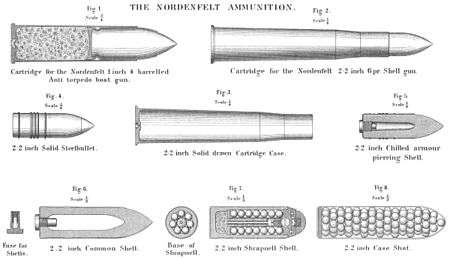QF 6 pounder Nordenfelt
| QF 6 pounder Nordenfelt | |
|---|---|
|
48 calibres version at Gyltö, western archipelago of Finland, 1999. Photo by Ove Enqvist | |
| Type |
Naval gun Coast defence gun |
| Place of origin |
|
| Service history | |
| In service | 1885 - 19?? |
| Used by | Many countries |
| Production history | |
| Designed | 1885 |
| Manufacturer |
Nordenfelt Guns and Ammunition Company Maxim-Nordenfelt |
| Specifications | |
| Weight | UK 42-cal version : 638 pounds (289 kg) barrel & breech[1] |
| Length | various, 42-50 calibres |
|
| |
| Shell | Fixed QF 6 lb (2.7 kg) |
| Calibre | 57-millimetre (2.244 in) |
| Breech | Vertical sliding block with locking wedge |
| Muzzle velocity | 1,818 ft/s (554 m/s)[2] |
| Maximum firing range | 4,500–6,000 yd (4,100–5,500 m)[2] |
The QF 6 pounder Nordenfelt was a light 57 mm naval gun and coast defence gun of the late 19th century used by many countries.
Note that this gun should not be confused with the short-barreled 57 mm Cockerill-Nordenfelt "Canon de caponnière" or fortification gun, which was used to arm the German A7V tank in World War I.
Nordenfelt guns can be visually differentiated from equivalent and similar Hotchkiss guns by having slimmer barrels than the Hotchkiss, hence the Nordenfelt was considerably lighter.
United Kingdom
The UK adopted a 42-calibres (i.e. 95 inch bore) version as Ordnance QF 6 pounder Nordenfelt [note 1] Mk I, Mk II, Mk III.
United Kingdom Naval service

They were originally mounted from 1885 onwards for use against the new (steam-driven) torpedo boats which started to enter service in the late 1870s. The Nordenfelt gun was adopted at the same time as the very similar QF 6 pounder Hotchkiss, but the Navy was not satisfied with the special Nordenfelt ammunition and fuzes. Following the explosion in 1900 of an ammunition ship due to defective fuses, Britain replaced Nordenfelt fuzes with the Hotchkiss design. Nordenfelt guns were phased out in favour of the Hotchkiss and were declared obsolete by 1919.[3]
Finland
When Finland gained its independence from Russia In 1917 dozens of QF 6 pounder Nordenfelt cannons were stationed in Finland. After the Finnish Civil War in 1918 around 35 - 40 Nordenfelt cannons became available to the Finnish army. These guns were later used as a standard light coastal gun of the Finnish coastal artillery and were in service until the 1950s. During World War II some of these guns were also used as fortification artillery and bunker guns in the Mannerheim Line.[4]
Ammunition
Diagrams showing the proprietary Nordenfelt 1-inch (top left) and 6-pounder (all others, labelled "2.2 inch") ammunition designs :

Surviving examples
- A gun at Royal Queensland Yacht Squadron, Manly, Queensland, Australia
- A gun at the Manege Military Museum, Helsinki, Finland
See also
Weapons of comparable role, performance and era
- QF 6 pounder Hotchkiss : Hotchkiss equivalent
Notes
- ↑ British forces traditionally denoted smaller ordnance by the weight of its standard projectile, in this case 6 pounds (2.7 kg).
References
- ↑ Hogg & Thurston 1972, page 39
- 1 2 Hogg & Thurston 1972, Page 39 quote 7,500 yards (6,900 m) with muzzle velocity 1,773 ft/s (540 m/s), for the British 42-calibres model in 1914 using 7.75 oz cordite Mk 1 propellant. The Victorian Navy manual of 1895 quotes a muzzle velocity of 1,818 ft/s (554 m/s) using a 1 lb 15 oz (0.88 kg) gunpowder charge, but maximum range of only 5,000 yards (4,600 m). Text Book of Gunnery 1902, Page 337 quotes m.v. of 1,818 ft/s (554 m/s) and maximum range 4,500 yards (4,100 m). 5600 metres is quoted for the 48 calibres model at Krepost Sveaborg, Helsinki.
- ↑ Hogg & Thurston 1972, Page 36
- ↑ http://www.jaegerplatoon.net/COASTAL_ARTILLERY1.htm#5748
Bibliography
- Text Book of Gunnery, 1902. LONDON : PRINTED FOR HIS MAJESTY'S STATIONERY OFFICE, BY HARRISON AND SONS, ST. MARTIN'S LANE
- I.V. Hogg and L.F. Thurston, British Artillery Weapons & Ammunition 1914-1918. London: Ian Allan, 1972.
External links
| Wikimedia Commons has media related to QF 6 pounder Nordenfelt. |
- Handbook for the Nordenfelt 6-PR quick firing guns Marks I and II. Great Britain. Admiralty. London : Printed for Her Majesty's Stationery Office by Eyre & Spottiswoode 1887 at State Library of Victoria
- Handbook of the 6 pounder Nordenfelt quick-firing gun. Land service 1892, 1900 at State Library of Victoria
- Handbook of the Nordenfelt 6-pr. quick-firing guns, marks I and II, 1897 at State Library of Victoria
- Victorian Naval Forces manuals 1890 & 1895. Includes QF 6 pounder Nordenfelt details. From Friends of the Cerberus website
- Nordenfelt 6 pdr Quick Firer History, technical details, animations
